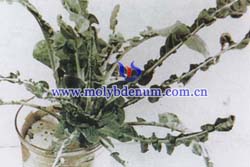Broccoli Molybdenum Deficiency

As broccoli molybdenum deficiency is closely linked to nitrogen that, its deficiency can easily resemble nitrogen deficiency. Molybdenum is the only micronutrient that is mobile within the plant so deficiency symptoms show up on older and middle leaves, but it spreads up the stem and affects the new leaves. In poinsettias, it shows up as thin chlorotic leaf margins around the leaf perimeter and then the margins become necrotic. In some crops the whole leaf turns pale and can also be followed by marginal necrosis. Leaves can be misshapen and in the case of cauliflower it can cause ‘whiptail’ in which the midrib of the leaf grows but there is severe restriction on the width of the leaf blade, making the leaves narrow. In advanced stages, plant growth and flower formation will be restricted. Crops that are most sensitive to molybdenum deficiency are crucifers (broccoli, cauliflower, cabbage), legumes (beans, peas, clovers), poinsettias and primula.
Since molybdenum is needed to convert nitrate to ammonia within the plant, feeding with mostly nitrate fertilizer will induce a molybdenum deficiency sooner than feeding with ammoniacal fertilizer. Research has shown that high sulfates can reduce plant uptake of molybdenum. Molybdenum is the only micronutrient that becomes unavailable as the growing medium pH decreases. So if a deficiency occurs, check the pH of the growing medium. If the pH is ideal for the crop, then consider adding a molybdenum fertilizer supplement as discussed below.
If you have got any interest in molybdenum metals, please feel free to contact us by email: sales@chinatungsten.com, sales@xiamentungsten.com or by telephone:86 592 512 9696/86 592 512 9595.
Related Links: Molybdenum News & Prices
